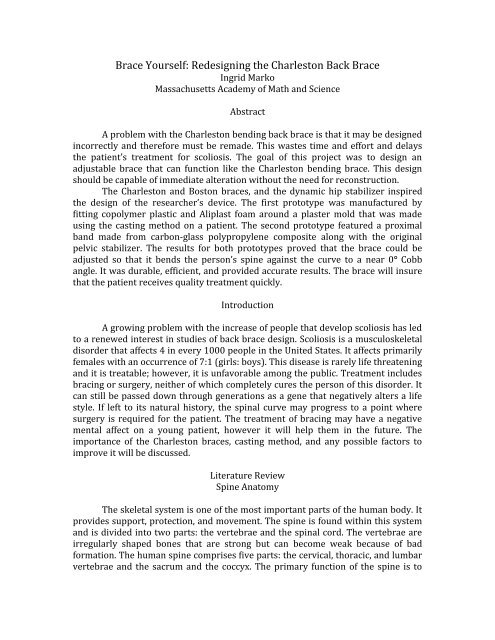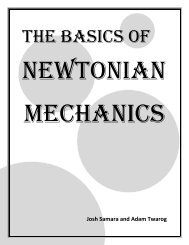Brace Yourself: Redesigning the Charleston Back Brace
Brace Yourself: Redesigning the Charleston Back Brace
Brace Yourself: Redesigning the Charleston Back Brace
You also want an ePaper? Increase the reach of your titles
YUMPU automatically turns print PDFs into web optimized ePapers that Google loves.
<strong>Brace</strong> <strong>Yourself</strong>: <strong>Redesigning</strong> <strong>the</strong> <strong>Charleston</strong> <strong>Back</strong> <strong>Brace</strong><br />
Ingrid Marko<br />
Massachusetts Academy of Math and Science<br />
Abstract<br />
A problem with <strong>the</strong> <strong>Charleston</strong> bending back brace is that it may be designed<br />
incorrectly and <strong>the</strong>refore must be remade. This wastes time and effort and delays<br />
<strong>the</strong> patient’s treatment for scoliosis. The goal of this project was to design an<br />
adjustable brace that can function like <strong>the</strong> <strong>Charleston</strong> bending brace. This design<br />
should be capable of immediate alteration without <strong>the</strong> need for reconstruction.<br />
The <strong>Charleston</strong> and Boston braces, and <strong>the</strong> dynamic hip stabilizer inspired<br />
<strong>the</strong> design of <strong>the</strong> researcher’s device. The first prototype was manufactured by<br />
fitting copolymer plastic and Aliplast foam around a plaster mold that was made<br />
using <strong>the</strong> casting method on a patient. The second prototype featured a proximal<br />
band made from carbon-glass polypropylene composite along with <strong>the</strong> original<br />
pelvic stabilizer. The results for both prototypes proved that <strong>the</strong> brace could be<br />
adjusted so that it bends <strong>the</strong> person’s spine against <strong>the</strong> curve to a near 0° Cobb<br />
angle. It was durable, efficient, and provided accurate results. The brace will insure<br />
that <strong>the</strong> patient receives quality treatment quickly.<br />
Introduction<br />
A growing problem with <strong>the</strong> increase of people that develop scoliosis has led<br />
to a renewed interest in studies of back brace design. Scoliosis is a musculoskeletal<br />
disorder that affects 4 in every 1000 people in <strong>the</strong> United States. It affects primarily<br />
females with an occurrence of 7:1 (girls: boys). This disease is rarely life threatening<br />
and it is treatable; however, it is unfavorable among <strong>the</strong> public. Treatment includes<br />
bracing or surgery, nei<strong>the</strong>r of which completely cures <strong>the</strong> person of this disorder. It<br />
can still be passed down through generations as a gene that negatively alters a life<br />
style. If left to its natural history, <strong>the</strong> spinal curve may progress to a point where<br />
surgery is required for <strong>the</strong> patient. The treatment of bracing may have a negative<br />
mental affect on a young patient, however it will help <strong>the</strong>m in <strong>the</strong> future. The<br />
importance of <strong>the</strong> <strong>Charleston</strong> braces, casting method, and any possible factors to<br />
improve it will be discussed.<br />
Literature Review<br />
Spine Anatomy<br />
The skeletal system is one of <strong>the</strong> most important parts of <strong>the</strong> human body. It<br />
provides support, protection, and movement. The spine is found within this system<br />
and is divided into two parts: <strong>the</strong> vertebrae and <strong>the</strong> spinal cord. The vertebrae are<br />
irregularly shaped bones that are strong but can become weak because of bad<br />
formation. The human spine comprises five parts: <strong>the</strong> cervical, thoracic, and lumbar<br />
vertebrae and <strong>the</strong> sacrum and <strong>the</strong> coccyx. The primary function of <strong>the</strong> spine is to
support and protect <strong>the</strong> spinal cord. Each of <strong>the</strong> vertebrae include a neural arch<br />
made from two pedicles and two arched laminae, that make up <strong>the</strong> body; a vertebral<br />
foramen, that allows <strong>the</strong> spinal cord to pass through; spinous process, superior and<br />
inferior articular processes, and an intervertebral foramen for <strong>the</strong> transit of spinal<br />
nerves (Van De Graff, Kent, & Ward, 2002).<br />
The main vertebrae of <strong>the</strong> spine are <strong>the</strong> thoracic and <strong>the</strong> lumbar, and <strong>the</strong><br />
curves in scoliosis are usually found in <strong>the</strong>se regions. The thoracic vertebra connects<br />
to <strong>the</strong> rib cage while <strong>the</strong> lumbar vertebrae connects to <strong>the</strong> surrounding muscle.<br />
Intravertable disks connected through interlocked processes and ligaments support<br />
each of <strong>the</strong> vertebrae. There is finite movement between <strong>the</strong> vertebrae alone, but a<br />
wide range of movement from <strong>the</strong> spinal column itself (Van de Graff et al., 2002).<br />
Figure 1. Lateral side of <strong>the</strong> spinal column. This side view depicts<br />
<strong>the</strong> five parts of <strong>the</strong> spine showing <strong>the</strong> cervical, thoracic, lumbar,<br />
sacral, and coccyx sections. This spine does not show <strong>the</strong> scoliosis<br />
disorder (Bridwell, n.d.).
Figure 2. Vertebrae of <strong>the</strong> spinal column. This image shows all of<br />
<strong>the</strong> vertebrae in <strong>the</strong> spine. The T’s referrer to <strong>the</strong> thoracic region<br />
and <strong>the</strong> L’s to <strong>the</strong> lumbar (Galliani, n.d.)<br />
In scoliosis, <strong>the</strong> vertebrae shift or do not form in <strong>the</strong> correct area, thus<br />
leading to a defected spinal shape. In some cases, <strong>the</strong> curve can be large and prevent<br />
important body functions. But, in most cases <strong>the</strong> curve can be fixed through certain<br />
types of treatment.<br />
Morphology of Adolescent Idiopathic Scoliosis (AIS)<br />
Scoliosis is a condition in which a patient has a deformed spine. It occurs<br />
frequently in growing children, but primarily in girls. Sometimes, a curve may be<br />
small during childhood but can progress through time into adulthood. Treatment<br />
becomes more difficult at this time. The curves in <strong>the</strong> spine can occur at any part of<br />
<strong>the</strong> vertebrae, from <strong>the</strong> thoracic to <strong>the</strong> lumbar regions and <strong>the</strong>re can be rotation in<br />
<strong>the</strong> individual as well. There are several contributing factors that can account for<br />
why this occurs, but <strong>the</strong>re is not any known cause.<br />
Scoliosis can form in children due to intervertebral motion coupling, spinal<br />
buckling, and/or an imbalance in <strong>the</strong> muscles/bone growth (Stokes& Aubin, 2006).<br />
Generally, a lack of nutrition in growing children can lead to scoliosis because <strong>the</strong><br />
rate of <strong>the</strong>ir skeletal growth is affected along with <strong>the</strong> strength of <strong>the</strong>ir bones.<br />
Treatment for scoliosis includes bracing or surgery. There are different types<br />
of braces used presently and each performs in a slightly different way. Sometimes,<br />
doctors decide not to treat <strong>the</strong> patient if <strong>the</strong> curve is small and does not seem to be a<br />
health risk. In o<strong>the</strong>r cases, patients may be taken directly into surgery.<br />
Current Treatment for Patients with AIS<br />
Knowledge of determining whe<strong>the</strong>r patients need surgery is essential in<br />
figuring out what type of treatment is necessary for <strong>the</strong>m. An orthopedic doctor has<br />
<strong>the</strong> choice of providing a patient with treatment. They may recommend surgery if<br />
<strong>the</strong> curve is large or some form of bracing. The common braces used are <strong>the</strong> Boston<br />
brace, which uses pressure pads to correct <strong>the</strong> curve; and <strong>the</strong> <strong>Charleston</strong> bending
ace, which is used to bend against <strong>the</strong> curve. The Milwaukee brace is rarely used<br />
anymore because <strong>the</strong> previous two braces are more modern and efficient. The main<br />
difference between <strong>the</strong>m is that <strong>the</strong> Boston brace is worn for 23 hours a day, while<br />
<strong>the</strong> <strong>Charleston</strong> type is worn only during <strong>the</strong> night for about 8 hours. Some doctors<br />
do not believe in <strong>the</strong> effectiveness of <strong>the</strong> <strong>Charleston</strong> brace because it is worn for<br />
small lengths of time, but studies have proven that it is just as effective as <strong>the</strong><br />
former. Unlike <strong>the</strong> Boston brace, however, it does not take <strong>the</strong> rotation of <strong>the</strong><br />
vertebrae into consideration (personal communication).<br />
Figure 3. <strong>Charleston</strong> bending back brace. The figure shows a person<br />
wearing <strong>the</strong> brace in a sleeping position. The brace is bending <strong>the</strong>ir torso<br />
against <strong>the</strong> curve of <strong>the</strong>ir scoliosis. It is typically worn for about 8 hours a<br />
night (“Types of braces”, 2007).<br />
Before having a brace made, <strong>the</strong> doctor will give <strong>the</strong> patient an x-ray to<br />
measure his curve. The Cobb angles indicate <strong>the</strong> measurement and <strong>the</strong>y are used to<br />
find two curves in <strong>the</strong> spine, usually in <strong>the</strong> thoracic and lumbar regions. In each<br />
measurement, <strong>the</strong> maximal inclination to <strong>the</strong> o<strong>the</strong>r maximal inclination, found at <strong>the</strong><br />
end plates of <strong>the</strong> vertebrae, is used to calculate <strong>the</strong> angle (Stokes & Aubin, 2006).<br />
After <strong>the</strong> initial x-rays are taken, <strong>the</strong>y will be sent to an orthotist who will<br />
make <strong>the</strong> brace. Recently orthotic and pros<strong>the</strong>tic experts have expressed an interest<br />
in developing new ways to design and manufacture back braces with quicker and<br />
better results. However, <strong>the</strong> original casting method is mainly used. After <strong>the</strong> brace<br />
is made, <strong>the</strong> doctor will tell <strong>the</strong> patient how it should be used and for how long it<br />
should be worn. It is <strong>the</strong> patient’s responsibility to follow <strong>the</strong> orders. If worn<br />
properly, <strong>the</strong> brace will be successful.<br />
The Casting Method<br />
The casting method is a procedure in which an orthotist makes <strong>the</strong> brace<br />
using a casting of <strong>the</strong> patient’s torso. First an initial clinical exam should take place
in which <strong>the</strong> orthotist can take note of <strong>the</strong> patient’s flexibility and guide him on<br />
planning out <strong>the</strong> appearance of <strong>the</strong> brace before <strong>the</strong> procedure is conducted.<br />
Some flexibility tests include having a patient bend over and reaching his<br />
toes, and standing up straight <strong>the</strong>n bending laterally. Resistive force may be<br />
necessary to see <strong>the</strong> stiffness of his spine.<br />
Afterwards, a standing x-ray should be taken for <strong>the</strong> brace planning. The x-<br />
ray becomes <strong>the</strong> blue print used in planning out <strong>the</strong> <strong>Charleston</strong> brace design for a<br />
patient. Several angles are measured and <strong>the</strong> placements of <strong>the</strong> corrective forces are<br />
determined. When making <strong>the</strong> blue print <strong>the</strong> orthotist should consider <strong>the</strong> sacrum<br />
visible mark for <strong>the</strong> center line, <strong>the</strong> vertebral tilt angle which determines <strong>the</strong> limits<br />
of each scoliotic curve, <strong>the</strong> pelvic tilt angle, <strong>the</strong> lumbar/pelvic relationship angle,<br />
and <strong>the</strong> Cobb angle which is extremely important in locating <strong>the</strong> superior and<br />
inferior bodies in <strong>the</strong> curvature (Ralph Hooper, Reed, & Price, 2003).<br />
The x-ray of <strong>the</strong> spine should be studied carefully to determine where <strong>the</strong><br />
forces would be applied for unbending. The first main force is <strong>the</strong> lateral shift force.<br />
This force should move <strong>the</strong> spine beyond <strong>the</strong> centerline and maintain that position<br />
during unbending (Ralph Hooper et al., 2003). It must never be compromised or<br />
ignored. The stabilizing force is applied near <strong>the</strong> bottom of <strong>the</strong> lumbar curve and <strong>the</strong><br />
pelvic area. The unbending force is <strong>the</strong> main curve reducing force in which pressure<br />
is applied opposite <strong>the</strong> lateral shift force.<br />
Figure 4. Applied forces for unbending. The figure shows a crooked spine with<br />
<strong>the</strong> three main forces labeled. It accurately depicts how <strong>the</strong> placement of <strong>the</strong><br />
forces and how <strong>the</strong>y work toge<strong>the</strong>r to unbend a patients spine (Ralph Hooper<br />
et al., 2003).<br />
The classifications of <strong>the</strong> scoliotic curves are very important to an orthotist.<br />
These are used in correction techniques and <strong>the</strong>y help define curves and act as<br />
reminders on how to treat specific ones. The Kings classification describes five types<br />
of curves. Type one is S-shaped and both <strong>the</strong> thoracic and lumbar curves cross <strong>the</strong><br />
midline and <strong>the</strong> lumbar curve is longer than <strong>the</strong> thoracic one (Ralph Hooper et al.,<br />
2003).
Figure 5. King type one curve. This curve is a type one and it depicts <strong>the</strong><br />
applications and location of <strong>the</strong> forces (Ralph Hooper et al., 2003).<br />
King type two curves are very similar to <strong>the</strong> type one curves. They are both S-<br />
shaped and both <strong>the</strong> thoracic and lumbar curves cross <strong>the</strong> midline. Here, however,<br />
<strong>the</strong> thoracic curve is greater than <strong>the</strong> lumbar one (Ralph Hooper et al., 2003).<br />
Figure 6. King type two curve. This shows <strong>the</strong> curve with <strong>the</strong> applied<br />
forces correctly labeled. If unbending is successful, <strong>the</strong> curve should<br />
appear nearly straight (Ralph Hooper et al., 2003).<br />
Type three curves are <strong>the</strong> easiest to correct and <strong>the</strong>y have an overhang<br />
appearance. They are mainly thoracic curves and <strong>the</strong> lumbar segment does not cross<br />
<strong>the</strong> midline in this case.
Figure 6. King type three curve. The curve is relatively simple to<br />
correct. The applied forces are labeled and <strong>the</strong> curve lies in <strong>the</strong><br />
thoracic region (Ralph Hooper et al., 2003).<br />
The type four curves are long and located in <strong>the</strong> thoracic region. The<br />
vertebrae can be centered over <strong>the</strong> sacrum. Here <strong>the</strong> spine should be shifted to <strong>the</strong><br />
midline before being unbent (Ralph Hooper et al., 2003).<br />
Figure 7. King type four curve. The curve in <strong>the</strong> thoracolumbar area is<br />
bent over <strong>the</strong> sacrum and can align with <strong>the</strong> edge of <strong>the</strong> pelvis. Shifting<br />
this curve to <strong>the</strong> midline is important (Ralph Hooper et al. 2003).<br />
Type five curves are very similar to <strong>the</strong> type four curves in <strong>the</strong> way <strong>the</strong>y are<br />
treated. These types of curves are double thoracic instead of single. They are also<br />
rarely treated with <strong>the</strong> <strong>Charleston</strong> bending back brace (Ralph Hooper et al., 2003).
Figure 8. King type five curve. There is a double thoracic curve that<br />
passes over <strong>the</strong> sacrum. This is treated <strong>the</strong> same way as <strong>the</strong> type 4<br />
(Ralph Hooper et al. 2003).<br />
Once <strong>the</strong> patients x-ray has been closely examined and classified as one of<br />
<strong>the</strong> King types, <strong>the</strong> patient will be called in for ano<strong>the</strong>r appointment. The mold of<br />
<strong>the</strong>ir torso will be made with stockinettes. Measurements of <strong>the</strong> patient will also be<br />
taken and markings will be placed on <strong>the</strong> cast, which will be filled with plaster<br />
afterwards. The plaster will be taken to <strong>the</strong> workshop and fixed (if needed) before<br />
having <strong>the</strong> plastic heated and placed on it. Once <strong>the</strong> brace is completed, <strong>the</strong> patient<br />
will come in for a fitting before taking <strong>the</strong> brace with <strong>the</strong>m (Ralph Hooper et al.,<br />
2003). An x-ray of <strong>the</strong> patient with <strong>the</strong> brace on is taken of <strong>the</strong>m in <strong>the</strong> supine<br />
position to make sure it functions correctly. If <strong>the</strong> brace is incorrect, a new one has<br />
to be made. About 1 out of 20 braces have to be remade due to error and incorrect<br />
function (personal communication). The main source of error is due to <strong>the</strong> use of<br />
educated guessing of when and where <strong>the</strong> forces are applied and how much<br />
pressure is used (personal communication).<br />
X-Rays<br />
Philips Digital Diagnost, V 2.0, is an x-ray machine used in medical offices. It<br />
has a moveable vertical stand, height adjustable table that includes a ceiling<br />
suspension system and uses a wireless portable detector. It can cover vertical,<br />
horizontal, and cross lateral positions of a patient. The x-ray dose that is emitted<br />
from <strong>the</strong> machine to digitally capture <strong>the</strong> image is low and does not greatly<br />
endanger <strong>the</strong> patient’s health (“Digital diagnost”, n.d.).<br />
The camera captures <strong>the</strong> image and wirelessly transports it through a<br />
network system. The image can be accessed through IDX Imagecast, an online<br />
program that allows <strong>the</strong> medical practitioners, or orthopedic doctors, to observe <strong>the</strong><br />
x-ray and calculate Cobb angles.
Figure 9. Philips digital diagnost, v 2.0. This is <strong>the</strong> x-ray<br />
currently being used in medical facilities. It reduces x-<br />
ray emission and is moveable to take a variety of images<br />
(“Digital diagnost”, n.d.).<br />
Patents<br />
The Dynamic Hip Stabilizer is a device used to reduce any hip<br />
dislocations after a surgery or prevent rotation and translation. The device consists<br />
of a pelvic girdle, one thigh cuff, and one or more straps that connect to <strong>the</strong> girdle.<br />
The design of <strong>the</strong> pelvic girdle goes around <strong>the</strong> patient’s hips and prevents and<br />
controlls any movements (U.S. Patent No. 20040116260A1, 2009).<br />
Figure 10. Dynamic hip stabilizer. The top portion of this device<br />
is <strong>the</strong> pelvic girdle which was used as a model for <strong>the</strong><br />
experiment. It controls or prevents any unwanted hip<br />
movements (U.S. Patent No. 20040116260A1, 2009).<br />
The <strong>Charleston</strong> bending back brace was produced in 1989 and is worn while<br />
<strong>the</strong> patient is asleep. It is designed for patients with scoliosis and it works by<br />
bending <strong>the</strong>ir backs against <strong>the</strong> curve. The brace provides a lateral shift force,<br />
unbending force, and a stabilizing force (U.S. Patent No. 2007/0010768A1, 2010).
Figure 11. <strong>Charleston</strong> bending brace. This is used to treat AIS n<br />
patients and works by bending <strong>the</strong>ir spine against <strong>the</strong> curve. It is<br />
worn in <strong>the</strong> nighttime (Cowan, 2008).<br />
The Boston brace is worn for 23 hours a day and it is not curved, but straight<br />
and rigid. It uses pressure pads that push <strong>the</strong> spine into a straighter position. The<br />
brace also exerts a force on <strong>the</strong> ribs and back and gives <strong>the</strong> patient a near perfect<br />
upright posture. The only problem with using <strong>the</strong> brace is that it can lead to a loss of<br />
flexibility in <strong>the</strong> patient’s spine due to <strong>the</strong> brace’s rigidness and <strong>the</strong> inability to move<br />
while wearing it (U.S. Patent No. 2007/0010768A1, 2010).<br />
Figure 12. Boston brace. This is <strong>the</strong> day brace worn by patients with<br />
scoliosis. It is rigid and straight and it corrects <strong>the</strong> spine by using pressure<br />
pads (“Types of braces for scoliosis”, 2007).<br />
Material Science<br />
Copolymer plastic sheets are a mix of polypropylene and low-density<br />
polyethylene. When <strong>the</strong>y are heated <strong>the</strong>y become self-adhesive and have <strong>the</strong> ability<br />
to be shaped when used with a vacuum. The sheets are usually heated between 163°<br />
C to 191 ° C and <strong>the</strong> Copolymer is less brittle than polypropylene alone, however <strong>the</strong><br />
plastic can experience blanching, shrinking, or bubbling during high stress and<br />
temperatures (“Polypropylene-co-polymer plastic sheets”, n.d.).<br />
Polypropylene is a resin composed of <strong>the</strong> polymerization of propylene. These<br />
plastics are tough, flexible, lightweight, and heat resistant. The propylene compound<br />
is obtained by <strong>the</strong> <strong>the</strong>rmal cracking of ethane, propane, butane, and <strong>the</strong> naphtha<br />
fraction of petroleum. The chemical structure of this is CH2=CHCH3 and consists of<br />
carbon atoms bonded to hydrogen atoms. The polypropylene is stiffer, stronger,<br />
harder, and softens at much higher temperatures than polyethylene<br />
(“Polypropylene”, 2012).<br />
Polyethylene is a syn<strong>the</strong>tic resin made from <strong>the</strong> polymerization of Ethylene.<br />
The gaseous hydrocarbon is made from cracking ethane that can be retrieved from
natural gas or distilled petroleum. The chemical compound appears in <strong>the</strong> form of<br />
C2H4, which is composed of two methylene units linked to carbon atoms by a double<br />
bond. When <strong>the</strong> structure repeats itself many times, it becomes Polyethylene. The<br />
low-density version of <strong>the</strong> plastic occurs when <strong>the</strong> structure becomes branched due<br />
to high temperatures. The branches prevent <strong>the</strong> molecules form packing close<br />
toge<strong>the</strong>r, thus resulting in a soft and versatile material (“Polyethylene”, 2012).<br />
Polyethylene is also used to make foams such as Aliplast, which are water,<br />
bacteria, and odor resistant. Cellular foam is composed of plastic in gas bubbles,<br />
which are <strong>the</strong>rmoplastic and opened-celled. They can undergo a great deal of<br />
compression and pressure (Kuncir, Wirta, & Golbranson, 1990).<br />
Carbon-glass polypropylene composite is a combination of carbon fiber cloth<br />
and two layers of polypropylene plastic. The carbon fiber cloth is placed in between<br />
<strong>the</strong> polypropylene layers and after it is heated it becomes very rigid. The product, in<br />
use, may cause skin and eye irritation if exposed to <strong>the</strong>m.<br />
Engineering Plan<br />
Engineering problem being addressed:<br />
A problem with <strong>the</strong> <strong>Charleston</strong> bending back brace is that it may be designed<br />
incorrectly and <strong>the</strong>refore must be remade. This wastes time and effort and delays<br />
<strong>the</strong> patient’s treatment for scoliosis.<br />
Engineering Goals:<br />
The goal of this project was to design an adjustable brace that can function like <strong>the</strong><br />
<strong>Charleston</strong> bending brace. This design should be capable of immediate alteration<br />
without <strong>the</strong> need for reconstruction.<br />
Description in detail of methods or procedures:<br />
The engineering design process will be followed in order to make a<br />
successful device. The design criteria for <strong>the</strong> project include: a working model that<br />
can be fit on <strong>the</strong> researcher with scoliosis that can bend her as necessary, little to no<br />
interference of <strong>the</strong> x-ray image, and reusability. An x-ray will be taken to test <strong>the</strong><br />
device on <strong>the</strong> author. If <strong>the</strong> torso can be bent in any way, while only pushing on <strong>the</strong><br />
desired pressure points, it will be considered a successful model. Power tools such<br />
as a pneumatic cast saw, industrial sander, and plastic-cooking oven will be used.<br />
Literature Cited<br />
Bridwell, K. (n.d.) Spinal curves. Retrieved November 14, 2011, from<br />
http://www.spineuniverse.com/anatomy/ spinal-curves<br />
Clin, J (2010). A biomechanical study of <strong>the</strong> charleston brace for <strong>the</strong> treatment of<br />
scoliosis. Spine, 35(19), E940-E947.
Cowan, S. (2008) Scoliosis of <strong>the</strong> spine. Retrieved February 12, 2012, from<br />
http://biomed.brown.edu/Courses/BI108/BI108_2008_Groups/group14/pa<br />
ges/devices. html<br />
Digital diagnost. (n.d.) Retrieved February 8, 2012, from<br />
http://www.healthcare.philips.<br />
com/us_en/products/xray/products/radiography/digital/digital diagnost/<br />
Drennan, D. (2009). U.S. Patent No. 20040116260A1. Washington D.C.: U.S. Patent<br />
and Trademark Office.<br />
Eldeeb, H., Boubekri, N., Asfour, S., Khalil, T., & Finnieston, A. (2001). Design of<br />
thoracolumbosacral orthosis (tlso) braces using ct/mr). Journal of Computer<br />
Assisted Tomography, 25(6), 963-70.<br />
Galliani, M. (n.d.) Chiropractic. Retrieved February 19, 2012, from http://<br />
www.bioenergyresearch.com/eng/chiropractic.htm<br />
Kuncir, E., Wirta, R., Golbranson, F. (1990). Load-bearing characteristics of<br />
polyethylene foam: an examination of structural and compression properties.<br />
Journal of Rehabilitation Research and Development, 27 (3), 229-238.<br />
Lonstein, J. E. (2006). Scoliosis: surgical versus nonsurgical treatment. Clinical<br />
Orthopedics and Related Research, 443(443), 248-259.<br />
Polyethylene, (2012). Encyclopaedia Britannica. Retrieved February 12, 2012, from<br />
http://www.britannica.com.ezproxy.wpi.edu/EBchecked/topic/468511/pol<br />
yethylene- PE/<br />
Polypropylene, (2012). Encyclopaedia Britannica. Retrieved February 12, 2012, from<br />
http://www.britannica.com.ezproxy.wpi.edu/EBchecked/topic/469069/pol<br />
ypropyl ene<br />
Polypropylene-co-polymer plastic sheets. (n.d.) JMS plastics. Retrieved February 12,<br />
2012, from http://www.jmsplastics.com/plastic_sheets/co_polymer.php.<br />
Ralph Hooper, C., Reed. F., Price, C. (2003) The charleston bending brace: an<br />
orthotist’s guide to scoliosis management. The <strong>Charleston</strong> Bending <strong>Brace</strong><br />
Foundation 1990.<br />
Richards, B. S., Bernstein, R. M., D'Amato, C. R., & Thompson, G. H. (2005).<br />
Standardization of criteria for adolescent idiopathic scoliosis brace studies.<br />
Spine, 30(18), 2068-2075.
Scott, D, Price, C (1997). Nighttime bracing for adolescent idiopathic scoliosis with <strong>the</strong><br />
<strong>Charleston</strong> bending brace: long term follow-up. Journal of Pediatric<br />
Orthopaedics, 17(6), 703-707.<br />
Simanovsky, N. (2010) U.S. Patent No. 2007/0010768A1. Washington D.C.: U.S.<br />
Patent and Trademark Office.<br />
Stokes, I. & Aubin, (2006). Biomechanics of scoliosis. Encyclopedia of Medical Devices<br />
and Instrumentation. (2 ed.). John Wiley & Sons, Inc.<br />
Types of braces for scoliosis. (2007) Retrieved November 14, 2011, from<br />
http://www.iscoliosis.com/ articles-brace_types.html<br />
Van De Graaff, Kent, M., Ward, R. (2002) Schaum's outline of human anatomy and<br />
physiology. Retrieved from http://site.ebrary.com/lib/wpi/<br />
Doc?id=5008157&ppg=5<br />
Acknowledgements<br />
The author wishes to thank several mentors who assisted in various aspects of this<br />
project. Ms. Julia Wildfong provided ongoing guidance and support in experiment<br />
design and execution. Karen Lynch provided a great aid in <strong>the</strong> design of <strong>the</strong> device<br />
and assisted in <strong>the</strong> making of <strong>the</strong> project. Dr. Errol Mortimer helped provide<br />
knowledge regarding scoliosis, recommended Ms. Lynch as a mentor, and most<br />
importantly aided <strong>the</strong> author in testing <strong>the</strong> device by allowing her to use x-rays.<br />
Jamison Haugen and John Gannon also provided a great deal of help in <strong>the</strong><br />
construction of <strong>the</strong> device. Mr. William Ellis aided <strong>the</strong> author with <strong>the</strong> force testing<br />
and data collection. Dr. Judith Sumner aided <strong>the</strong> author with editing her engineering<br />
paper. Her parents also contributed by providing transportation and moral support.
















